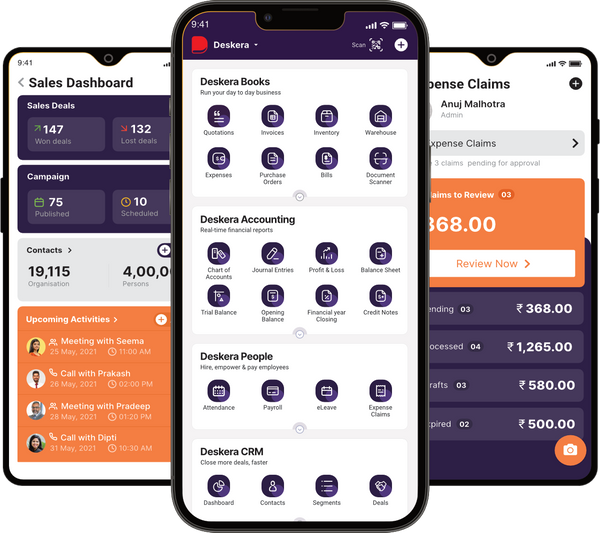Inventory valuation method is the way to calculate the total value of the inventory owned by a company at any particular time. The inventory value is calculated based on the total cost incurred in purchasing the inventory and getting it ready for sale in the market.
This is important in accounting where the valuation of any item plays a part in calculating Cost of Goods Sold and has a direct effect on the income statement & balance sheet.

In this article, we have explained the different inventory valuation methods with examples. Following are the topics covered:
- What Is Inventory Valuation?
- Why Is Inventory Valuation Important?
- The Rule of the Lower of Cost or Market
- What Are the Different Inventory Valuation Methods?
- How to Choose the Best Inventory Valuation Method?
- Challenges of Valuing Your Inventory
- Conclusion
- Key Takeaways
What Is Inventory Valuation?
Inventory valuation is a process in accounting that businesses use to determine the value of unsold inventory stock when they are producing their financial accounts. For an organization, inventory stock is an asset that must have a monetary value in order to be recorded on the balance sheet. Your inventory turnover ratio can be calculated using this value, which can help you plan your purchasing decisions.
As an illustration, suppose you own a shoe store and at the end of the year you still have 50 pairs of shoes. You must determine their financial worth and record it on your balance sheet. Let's examine the method and rationale behind your value calculation.
Costs Included in Inventory Valuation
Inventory is present at the end of an accounting period in both a finished and unfinished state. What do you think that investment is worth? You need pieces to assemble a bicycle.
However, you also need someone to assemble the pieces, and you have a number of extra overhead expenses. All of the expenses are accounted for in inventory valuation.
Direct labor- Whether they are paying hourly workers or salaried personnel, businesses spend a lot of money on labor. However, not all of that labor goes towards producing the goods. Therefore, only direct labor is taken into account when valuing inventories.
This includes the salaries paid to laborers who assemble the products, payroll taxes paid by the business, pension contributions, and any insurance premiums paid by the business (such as health, life, and workers' compensation).
Direct materials- Direct materials are any materials and supplies utilized in the production of a product. This includes any resources that are used up or thrown away during the procedure, as well as any broken or useless materials. Any cost that changes with each manufactured unit is, as a general rule, a direct cost.
Factory overhead- All costs incurred during the manufacturing process aside from direct labor and direct supplies are referred to as factory overhead. Examples include the wages paid to those working on the manufacturing of inventories but not the actual products, such as production managers, quality control specialists, and materials managers.
Rent, utilities, insurance, equipment setup, and maintenance costs are also included in factory overhead. Along with the depreciation expenses of larger equipment, it also covers the purchase price of minor industrial tools that are fully expensed at the time of acquisition.
Freight in- This is the price of shipping the items to the business. If a business offers free or cheap shipping to its consumers and bears the accompanying costs, there is a corresponding freight-out cost.
Handling- This comprises all the work required to get a finished product ready for delivery, such as picking the inventory, packing it, creating a shipping label, and loading it into a truck.
Import duties- Any imported components or supplies utilized in the creation of a company's goods may be subject to duty payments. Items that are exempt from duty due to trade agreements or for other reasons are examples.
Process for Inventory Valuation
Calculating inventory value follows a straightforward fundamental process.
- A business has an initial inventory that is valued in monetary units at the beginning of the accounting period.
- The amount of goods or inventory that the company has the potential to sell during the specified period is expressed as a sum known as Goods Available for Sale when net acquisitions for the period are added.
- Goods Available for Sale are divided into COGS and ending inventory at the conclusion of the quarter.
- Due to the fact that they will show up in different areas in a company's records, it is extremely important to allocate COGS and ending inventory correctly.
- In order to calculate the company's gross profit, sales are reduced from the cost of goods sold. On the income statement, that amount is subsequently shown.
- On the other hand, ending inventory is shown on the balance sheet of the business and is regarded as a current asset.
Why Is Inventory Valuation Important?
Only one step of inventory value involves locating the unsold items. A rate that you can multiply by the quantity is also necessary in order to arrive at a final value.
You might have paid various rates for these things during the course of the year, therefore you need to decide on a method to determine a standard cost. For the reasons listed below, inventory value is crucial.
Having an effect on the cost of goods sold
Less expense can be charged to the cost of products sold when a higher valuation for ending inventory is recorded, and vice versa. Thus, stated profit levels are significantly impacted by inventory valuation.
Evaluating the company's financial status
Inventories are included in the balance sheet and the statement of profit and loss. In order to avoid reflecting an erroneous financial condition, the valuation must be done appropriately.
Impact throughout Multiple Periods
Due to the fact that the incorrect ending balance in the first period transfers over into the incorrect beginning inventory balance in the subsequent reporting period, an incorrect inventory valuation will result in incorrect reported profits for two consecutive periods.
Changes in Loan Ratios
A restriction on the acceptable ratios of current assets to current liabilities may be included in the agreement if a lender has granted a loan to the organization in question. The lender may call the loan if the entity is unable to fulfil the target ratio. The inventory valuation can be important because it is typically the biggest part of this current ratio.
Evaluate the gross profit
The Cost of Goods Sold (COGS), when combined with Direct Revenue Earned (DRE), will assist you in calculating the Gross Profit. Finding out the cost of products sold is the first step in the method for computing gross profit.
COGS = Opening stock + Purchases + Direct Expenses – Closing Stock
When this is calculated, it is compared to sales, and the difference is either considered gross profit or gross loss, depending on the amount. The computations of net income are directly impacted by over- or understating the opening or closing stock, respectively. As a result, inventory valuation needs to be suitable and accurate.
Bringing in investors
You must have a strong company strategy to draw investors. Having a large profit margin means having this. Again, this can include selecting FIFO during inflationary periods and LIFO during deflationary periods. Make sure your portrayal is truthful at all costs; else, you can later find yourself in legal trouble.
Pleasing shareholders
The greatest strategy to keep shareholders pleased is to give them a fantastic return on their financial investment by selecting the best inventory valuation technique. Customers who are satisfied with their investments are more inclined to suggest your business to other potential customers and investors.
Liquidity evaluation
The majority of the working capital is made up of inventory. Inventory is not intended to be held for an extended period of time because it is a current asset. The company's liquidity levels are calculated using its inventory. In particular, the stock turnover ratio needs to be higher than average.
Statutory compliance
The company must provide the following information regarding inventory in accordance with the AS-2 and Ind AS-2 (value of inventories) guidelines:
- Inventory to be recognized as expense
- Carrying amount of inventories
- Accounting policies used in measurement
- Inventory write-down and reversal of write-down
Income Tax Effects
The amount of income taxes paid can vary depending on the cost-flow method selected. In order to lower income taxes paid during periods of rising prices, the LIFO approach is frequently utilised.
The Rule of the Lower of Cost or Market
If the market value of the inventory is lower than the recorded cost of the inventory, you may be forced to reduce the inventory valuation to the market value under the lower of cost or market rule.
Additionally, there are a few extremely rare situations in which you are permitted by international financial reporting requirements to record the cost of inventory at its market value, regardless of the cost to generate it (generally limited to agricultural produce).
When Should Inventory Use the Lower of Cost or Market Rule?
As time goes by, inventory value changes. A loss is occasionally experienced by the company when the market's appreciation of the inventory is less than the price paid to purchase it. In such a scenario, businesses can record the loss using the lowest of cost or market technique.
Businesses with outmoded inventory tend to choose the market or cost rule since it is less expensive. Usually, long-held inventory is cheaper at cost or at market. Also covered by the GAAP framework is the lower of cost or market rule.
What Are the Different Inventory Valuation Methods?
Three techniques are available for valuing inventory: FIFO (First In, First Out), LIFO (Last In, First Out), and WAC (Weighted Average Cost).
- In FIFO, you assume that the first products purchased will also be the first to depart the warehouse. To put it another way, under FIFO, every time you make a sale, the items are deducted from the first list of goods that arrived at your warehouse or store.
- In LIFO, you assume the exact opposite: that the last products to enter your store would be the first to exit.
- The WAC approach takes into account the item's yearly average cost. The entire cost is divided by the total number of units bought throughout the year to determine the average cost per unit.
- The specific identification method involves tracking each unique item in the inventory and allocating costs per item rather than grouping products together.
First-In, First-Out (FIFO)
According to the first-in-first-out (FIFO) valuation method, the inventory items are sold in the same order in which they are purchased or manufactured. The oldest inventory products are sold first as per the FIFO method. The FIFO valuation method is the most commonly used inventory valuation method as most of the companies sell their products in the same order in which they purchase it.
FIFO Valuation: Example
Let’s say a business bought Laptops at different timing and prices.
First transaction- Ten laptops at $1,000 each
Second transaction- Five laptops at $1,100 each
At the end of the month, the store had sold eight laptops.
With the FIFO valuation method, costing is calculated from the first transaction when the user purchased ten laptops at $1,000 each.
So, after selling eight laptops:
Accounting balance for COGS = (8 laptops x $1,000 each) = $ 8,000
Two laptops are still left from the first purchase, cost at $1000 each, as well as the five laptops from the second purchase at $1,100 each. So:
Accounting balance of Inventory account = (2 laptops x $1,000 cost) + (5 laptops at $1,100 cost) = $7,500
Pros
- Due to its simplicity, FIFO is a popular approach among e-commerce firms. Because the cost of each item sold using this method is always the same, a company cannot manipulate revenue by picking which item to sell.
- COGS are unaffected by any inventory that is held over from the previous fiscal year.
- Since FIFO values inventory in the order in which it was purchased and sold, it is frequently the case that the price determined corresponds to the actual costing involved because of its simplicity and intuitiveness, which makes it impossible to manipulate and avoid any suspicion.
- Another benefit is its simplicity because the costs match the actual cash flow and the physical flow of goods across the warehouse.
- Because the input cost is determined based on the order in which these commodities were created, purchases made at the end of the period under consideration have no impact on the calculations of revenue.
Cons
- It is typical in economics for product prices to rise over time. But occasionally these prices do increase quite quickly, particularly for agricultural goods that are impacted by extreme weather and climatic circumstances.
- Because the paper calculations do not support the actual inflated figures, FIFO occasionally results in a mismatch between expenses and income.
- Profits appear inflated even when regular inflation is assumed, which results in a heavier tax burden when compared to alternative approaches. No accounting regulations can benefit the company because it is so impossible to alter them.
Last-In, First-Out (LIFO)
The last-in-first-out (LIFO) inventory valuation method is precisely the opposite of the FIFO valuation method. It assumes that the most recently purchased or manufactured items are sold first.
LIFO Valuation: Example
Let’s say a business bought laptops at different timing and prices.
First transaction- Ten laptops at $1,000 each
Second transaction- Five laptops at $1,100 each
After selling 2 laptops:
Accounting balance for COGS = (2 laptops x $1,100 LIFO cost) = $2,200
Ten laptops are still left from the first purchase, cost at $1,000 each, as well as the three laptops from the second purchase at $1,100 each. So:
Accounting balance of Inventory account = (3 laptops at $1,100 cost) + (10 laptops at $1,000 cost) = $13,300
Pros
- There are tax benefits associated with employing LIFO, unlike FIFO. Higher COGS and a reduced balance of leftover inventory are the results of LIFO during periods of inflation.
- Taxes will be paid less by firms if COGS are higher and earnings are lower.
- As it takes into account the most recent cost, the LIFO mechanism's main benefit is that it more closely matches profitability.
- Because the equivalent net income is low, this is why profits are lower. Because of this, many accountants and regulators believe it is a useful tool for determining how profitable the management is.
- When compared to actual profits, it is far superior than the FIFO system, which generates enormous paper profits.
Cons
- A realistic inventory system does not use LIFO. Few firms (especially those selling goods with a short shelf life like cosmetics or anything with an expiration date) prefer to sell fresh inventory before old inventory.
- Using the most recent purchases as the cost of products sold in accounting or finance can result in a group of older inventory that is never "sold."
- The LIFO technique of inventory valuation is disapproved by a number of accounting authorities, including US GAAP. As a result, there is a risk related to the country and regulations.
Weighted Average Cost (or Avg Cost)
With the Weighted Average Cost inventory valuation method, inventory, and Cost of Goods Sold (COGS) are calculated based on the average cost of all items purchased during a period. This method is mainly used by businesses that don’t have variation in their inventory.
Weighted Avg Cost Valuation: Example
Let’s say a business bought Laptops at different timing and prices.
First transaction- Ten laptops at $1,000 each
Second transaction- Five laptops at $1,100 each
Here you have a total of 15 laptops, which you paid $15,500 for in total (10,000 + 5,500)
So, your weighted average cost would be the $15,500 cost divided by the 15 laptops, which is 1,033.33 per laptop.
After selling 13 laptops:
Accounting balance for COGS = (13 laptops x $1,033.33 average cost) = $13,433.33
Accounting balance of Inventory account = (2 laptops remaining x $1,033.33 average cost) = $2,066.67
In the above examples, we saw how the FIFO, LIFO and Weighted Avg Cost methods impact the accounting balances of COGS and Inventory accounts. Consequently, it impacts the income statement which uses the COGS account as an input, and the balance sheet which uses the Inventory account as an input.
Because purchase/cost prices generally keep rising over a period of time, income statements for companies which follow inventory valuation with FIFO usually show lower COGS and hence higher profit.
Pros
- For companies with a large quantity of inventory made up primarily of identical or extremely similar items, the weighted average cost method is frequently utilized. For instance, if you sell simple t-shirts in several sizes and colours, you may have many SKUs, but the price of each item is the same.
- To evaluate inventory using all three approaches, the weighted average computation is a very methodical and scientific approach. Both the date of purchase and the date of sale have no impact on it.
- The price at which these transactions were completed is the only factor that should be taken into consideration. As a result, it is simple to adopt, hassle-free to maintain, and easy to audit.
- This strategy is best used when the commodities under consideration are difficult to identify and it does not matter how they were obtained into the warehouse, similar to FIFO but different from LIFO in that it is difficult to manipulate.
Cons
- The possibility of selling things at a loss is a disadvantage of the weighted average approach. Why does this take place? Your pricing won't accurately reflect the value of an item if your costs suddenly increased and you're using a typical markup of COGS to determine prices.
- The cost of inventory frequently differs from the price of the commodities in the current market, which might raise questions because of the intricate calculations involved.
Specific Identification Method
When you want to keep track of the precise cost of each inventory item, you utilize the specific identification approach. When each inventory item is unique, like in an art museum, it is most frequently used.
- When a corporation is able to identify, mark, and track each item or unit in its inventory, the specific identification method is practical and usable.
- The specific identification method is most frequently used by smaller firms since they can quickly identify or count the products in their inventory.
- Larger organizations can also use electronic tags or stickers with serial numbers that can be scanned into an electronic inventory management system.
- Occasionally, the process can be completed by a worker simply observing the things and noting them on a sheet of paper.
- The specific identification approach is still employed in our day and age, where technology and computer programs seem to control everything, but inventory counts are now kept in a database.
- The ability to specifically identify the cost of each item purchased is also required by the specific identification method.
- For the cost to be closely related to the object, it must be simple to connect to the item's number or other distinguishing attribute. When the promise of sale is made, the object must also be easily tracked down, located, and accessible.
Pros
- The method has the advantage of having a much higher degree of accuracy when it comes to the actual number of items in inventory and, of course, a higher degree of accuracy when it comes to the amount of money made in revenue or profit, as well as any lost revenue if items are damaged, lost, or returned.
- Because of its accuracy, such a system almost eliminates the possibility of losing or misplacing inventory.
Cons
- The main disadvantage of the specific identification method is that it demands a firm grasp of how to quickly and reliably identify every single item in an organization's inventory, keep track of their costs, and produce them upon sale or the promise of sale.
- The cost of the item and the money obtained from the item's sale must be related to a particular item with some kind of unique identifier that marks it out.
- Because of the enormous volume that bigger firms, like big box retailers, transport every day, it is exceedingly difficult for them to accomplish the procedure.
- Smaller firms do not typically encounter this problem, which explains why these businesses are the ones that use the specific identification approach most frequently.
How to Choose the Best Inventory Valuation Method?
The market environment and your organization's financial objectives will influence the method you choose to value your inventory. Here are a few instances that can assist you in choosing the optimal inventory valuation method for your company.
1. Submitting an application for a loan to expand a business
Maintaining your stock as collateral is required if you intend to apply for a loan. It is best in these situations if your stock has a high value because a higher valuation will provide the lender more comfort. A FIFO inventory valuation method can provide you a better value for closing inventory if prices are rising all year long. A LIFO approach will provide you with a higher value if prices are falling.
Financial institutions consider the value of the closing inventory on your balance sheet as one of the criteria before providing a loan to a business, thus the method that provides you the largest inventory value will be beneficial for your business.
2. Bringing in new capital and maintaining shareholder satisfaction
A business with a large profit margin has a greater chance of attracting the interest of future investors while also satisfying its current owners. Therefore, FIFO valuation will be advantageous in an inflationary market if you're searching for fresh funding opportunities or if you want to delight your shareholders with good earnings. Additionally, when prices are declining, the LIFO value will be a superior option.
3. Saving taxes
Your method of inventory valuation can be useful if you're trying to reduce your tax liability. A LIFO valuation method will help you save some money, assuming once more that there is inflation.
What Do Companies Use Most Frequently?
Businesses most frequently employ FIFO because it lowers their tax obligations due to decreased cost of goods sold. Additionally, FIFO will help the issue of overstocking have a smaller impact on the company.
However, in some situations, the alternative approaches may be beneficial. When writing an annual report for shareholders, for instance, you can opt for the inventory valuation technique that yields the biggest net income or gross profits.
Challenges of Valuing Your Inventory
It might be difficult to determine the value of your inventory precisely unless you are a large company with millions of dollars spent in inventory tracking.
Working with an accountant makes inventory valuation simpler for startups and expanding enterprises. An order fulfilment company can make maintaining inventory easier. Proper inventory management is also crucial.
Large quantities
If your e-commerce business is expanding, you probably have thousands of units on hand. Calculating the inventory's current worth might be challenging without effective inventory management.
You can also be spending too much in carrying expenses if you're stocking more merchandise than you're selling, which chips away at your profits. A crucial component of inventory accounting is proper inventory management, which shouldn't be disregarded.
Inventory distributed geographically
Managing inventory can become much more difficult for companies whose stock is kept in different countries or throughout the United States.
With the help of fulfilment centres around the world, e-commerce companies may divide their inventory among different sites, expanding geographically and increasing customer reach while lowering shipping costs. Your supply chain can be optimized and data and reporting can be kept in one location by integrating fulfilment and inventory management.
Inventory Auditing
If you want to maintain your financial accounts and stock levels, inventory audits are a necessary evil. By performing this manually, small and medium-sized firms squander a lot of time that could be better used for business expansion and run the risk of accounting errors that cause inventory shrinkage (recording a higher inventory than there actually is, impacting profits).
Businesses may simply keep track of their inventory using inventory management software, maintaining an accurate count even as things sell, expire, etc.
How can Deskera Help You?
As a manufacturer, you must keep track of your inventory stock. The condition of your inventory has a direct impact on production planning, people and machinery use, and capacity utilization.
Deskera MRP is the one tool that lets you do all of the above. With Deskera, you can:
- Control production schedules
- Compile a Bill of Materials
- Produce thorough reports
- Make your own dashboard.
Deskera ERP is a complete solution that allows you to manage suppliers, track supply chain activity in real time, and streamline a range of other company functions.

Deskera Books allows you to manage your accounts and finances better. It helps maintain good accounting standards by automating billing, invoicing, and payment processing tasks.
Deskera CRM is a powerful tool that organizes your sales and helps you close deals rapidly. It enables you to perform crucial tasks like lead generation via email and gives you a comprehensive view of your sales funnel.
Deskera People is a straightforward application for centralizing your human resource management activities. Not only does the technology expedite payroll processing, but it also helps you to handle all other operations such as overtime, benefits, bonuses, training programs, and much more.
Conclusion
Choosing the right inventory valuation method is crucial as it has a direct impact on the business’s profit margin and accounting practices. Your choice of inventory valuation method can lead to a big difference in the cost of goods sold for your business.
To choose the right inventory valuation method for your company, consider the factors such as your business location, your business costs, and your inventory amount. Most businesses prefer using the FIFO method as it gives you a real picture of your costs and profitability.
The FIFO method gives you more accurate information as it assumes the older inventory items are less costly and are the ones sold first. Also, the FIFO method provides you with the highest profit as the first items in stock are often the cheapest. As a business owner, analyze all the three methods and choose the method that suits your specific business situation.
Key Takeaways
- Different businesses assess inventory value in different ways. Inventory valuation is an accounting method that establishes the monetary value of unsold inventory stock.
- The type of inventory valuation techniques utilized can have a big impact on the company's accounting.
- Since stock valuation methods are adapted to fit various production procedures, it is essential to select the appropriate method for a company's specific demands.
- The First In, First Out (FIFO), Last In, First Out (LIFO), First Expired, First Out (FEFO), Weighted Average, and Specific Identification are the five most popular methods for valuing inventories.
- The specific identification method refers to inventory valuation, specifically maintaining track of each distinct item in stock and allocating expenses per item rather than as a group.
Related Articles













